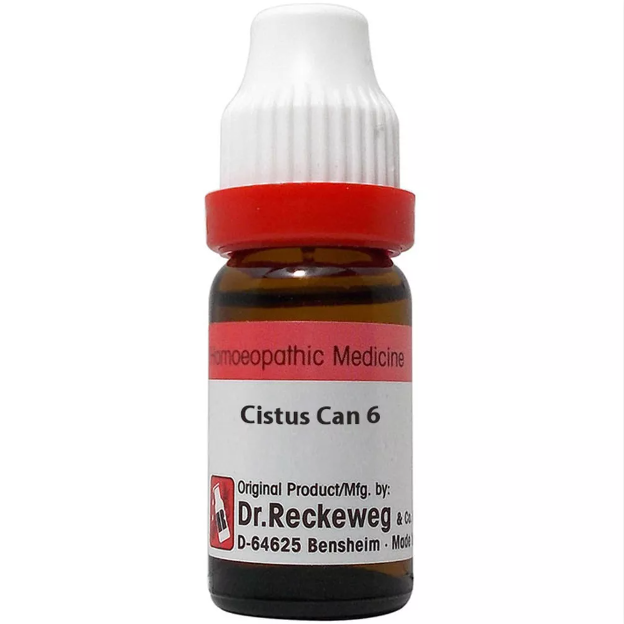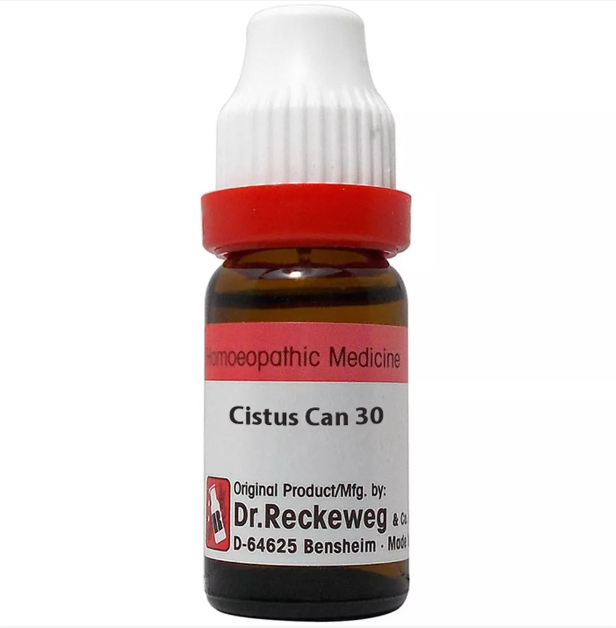CISTUS CANADENSIS 6C, 12C, 30C, 200C, 1M, 10M USES AND SYMPTOMS
 Cistus Canadensis
Cistus Canadensis
(Rock Rose)
Cist.
A potent, anti-psoric remedy focused on glandular issues, herpetic eruptions, and chronic swellings, particularly in those sensitive to cold. It induces sensations of coldness in various parts and treats scrofulous ophthalmia, poisoned wounds, bites, phagedenic ulcers, and carcinomatous neck glands. Cist. also targets the naso-pharynx, preventing colds centered in the posterior nose, and alleviates sniffling and migraines.
Ears: Watery discharge and fetid pus (otorrhea). Tetter around the ears extending to the external meatus.
Face: Itching, burning, and crusts on the right zygoma. Lupus, caries, open, bleeding cancer. Painful tip of the nose.
Mouth: Swollen, scorbutic gums. Cold sensation in the mouth with putrid breath. Pyorrhea. Painful tongue protrusion.
Throat: Spongy, dry, cold sensation causing pain when breathing. Swollen uvula and tonsils. Frequent sipping of water due to a dry spot. Mucus hawking. Swollen and suppurated throat glands (follicular tonsillitis). Neck drawn to one side by swellings (parotiditis). Sore throat from cold air inhalation. Heat and itching in the throat.
Stomach: Cool sensation in the stomach before and after eating. Entire abdomen feels cool. Craving for cheese.
Stool: Diarrhea from coffee and fruit, thin, yellow, urgent; worse in the morning.
Female: Induration and inflammation of breasts (mastitis). Sensitive to cold air. Foul-smelling leucorrhea.
Respiratory: Asthma after lying down, with a narrow trachea sensation, preceded by formication.
Chest: Cold sensation in the chest. Tumors on the neck. Induration of breasts. Lung hemorrhage.
Extremities: Sprained wrist pain. Fingers sensitive to cold. Tetter on hands. Cold feet. Syphilitic ulcers on lower limbs with hard swelling. White swelling.
Sleep: Insomnia due to throat coldness.
Skin: Itching, painful pimples, lupus, inflamed and indurated glands. Mercurio-syphilitic ulcers. Hard, thick, dry, fissured hand skin with deep cracks. General itching preventing sleep.
Modalities: Worse with slight exposure to cold air, mental exertion, excitement. Better after eating.
Relationship: Antidotes: Rhus-t., Sep. Compare: Con., Carb-v., Calc., Arg-n.
Dose: First to thirtieth attenuation. Use locally as a wash to arrest fetid discharges.
SYMPTOMS OF CISTUS CANADENSIS
Ears:
Watery discharge
Fetid pus (otorrhea)
Tetter around and extending to the external ear meatus
Face:
Itching and burning on the right zygoma
Crusts on the right zygoma
Lupus and caries
Open, bleeding cancer
Painful tip of the nose
Mouth:
Swollen, scorbutic gums
Cold sensation in the mouth
Putrid breath
Pyorrhea
Pain when protruding the tongue
Throat:
Spongy, dry, and cold feeling
Pain from very dry and cold air passing over parts
Swollen uvula and tonsils
Small, dry spot causing frequent sipping of water
Mucus hawking
Swelling and suppuration of throat glands (follicular tonsillitis)
Neck drawn to one side by swellings (parotiditis)
Sore throat from inhaling cold air
Heat and itching in the throat
Stomach:
Cool feeling in the stomach before and after eating
Cool feeling in the entire abdomen
Desire for cheese
Stool:
Diarrhea from coffee and fruit
Thin, yellow, urgent diarrhea, worse in the morning
Female:
Induration and inflammation of breasts (mastitis)
Sensitivity to cold air
Foul-smelling leucorrhea
Respiratory:
Asthma after lying down with a narrow trachea sensation, preceded by formication
Chest:
Cold sensation in the chest
Tumors on the neck
Induration of breasts
Hemorrhage from the lungs
Extremities:
Sprained pain in the wrist
Sensitivity to cold in the fingertips
Tetter on hands
Cold feet
Syphilitic ulcers on the lower limbs with hard swelling
White swelling
Sleep:
Insomnia due to throat coldness
Skin:
General itching, preventing sleep
Small, painful pimples
Lupus
Inflamed and indurated glands
Mercurio-syphilitic ulcers
Hard, thick, dry, and fissured skin on the hands with deep cracks
Itching in swollen hands and arms
selection of the potency
Individualization:
- Homeopathy is based on the principle of treating the individual, not just the disease. The unique symptoms and characteristics of the person are crucial in determining the most suitable potency.
Intensity of Symptoms:
- The intensity of the symptoms guides the choice of potency. If the symptoms are intense and acute, a lower potency (e.g., 6C, 30C) might be considered. For chronic conditions with less intensity, higher potencies (e.g., 200C, 1M) may be appropriate.
Sensitivity of the Patient:
- Some individuals are more sensitive to homeopathic remedies, while others may require higher potencies. The practitioner considers the patient’s sensitivity when selecting the potency.
Acute vs. Chronic Conditions:
- Lower potencies are often used for acute conditions, while higher potencies may be considered for chronic or long-standing issues.
Previous Response to Potencies:
- The patient’s response to previous homeopathic treatments helps guide the choice of potency. If a particular potency has been effective in the past, it may be repeated or adjusted as needed.
Vital Force and Susceptibility:
- Homeopathy views illness as a disturbance in the vital force. The practitioner assesses the patient’s overall vitality and susceptibility to determine the appropriate potency.
Aggravation or Amelioration:
- The direction of the symptom response (aggravation or amelioration) after taking a remedy can influence the choice of potency.
Miasmatic Considerations:
- In classical homeopathy, the concept of miasms (inherited disease tendencies) is considered. The practitioner take this into account when selecting the potency.
Practitioner Experience:
- The experience and preference of the homeopathic practitioner play a role. Some practitioners may have success with certain potencies based on their clinical experience.
SAFETY INFORMATION
- Do not exceed the recommended dose by physician
- Keep out of the reach of children
- Store in a cool dry place away from direct sunlight
- Maintain half an hour gap between food/drink/any other medicines and homoeopathic medicine
- Avoid any strong smell in the mouth while taking medicine e.g. camphor, garlic, onion, coffee, hing
Medicine images use for reference only selection of homeopathic medicine depends on the individual’s specific symptoms and overall constitution. Moreover, homeopathy is a holistic system of medicine that treats the individual as a whole. In addition to addressing the physical symptoms, it takes into account the emotional and mental state of the person. Consequently, it’s crucial to consult with a qualified homeopathic practitioner for personalized treatment.
The information provided on this website is intended solely for educational purposes. Always seek the advice of your physician or other qualified health provider.
